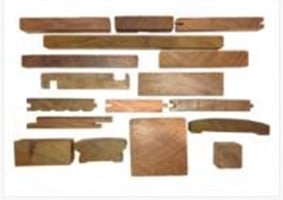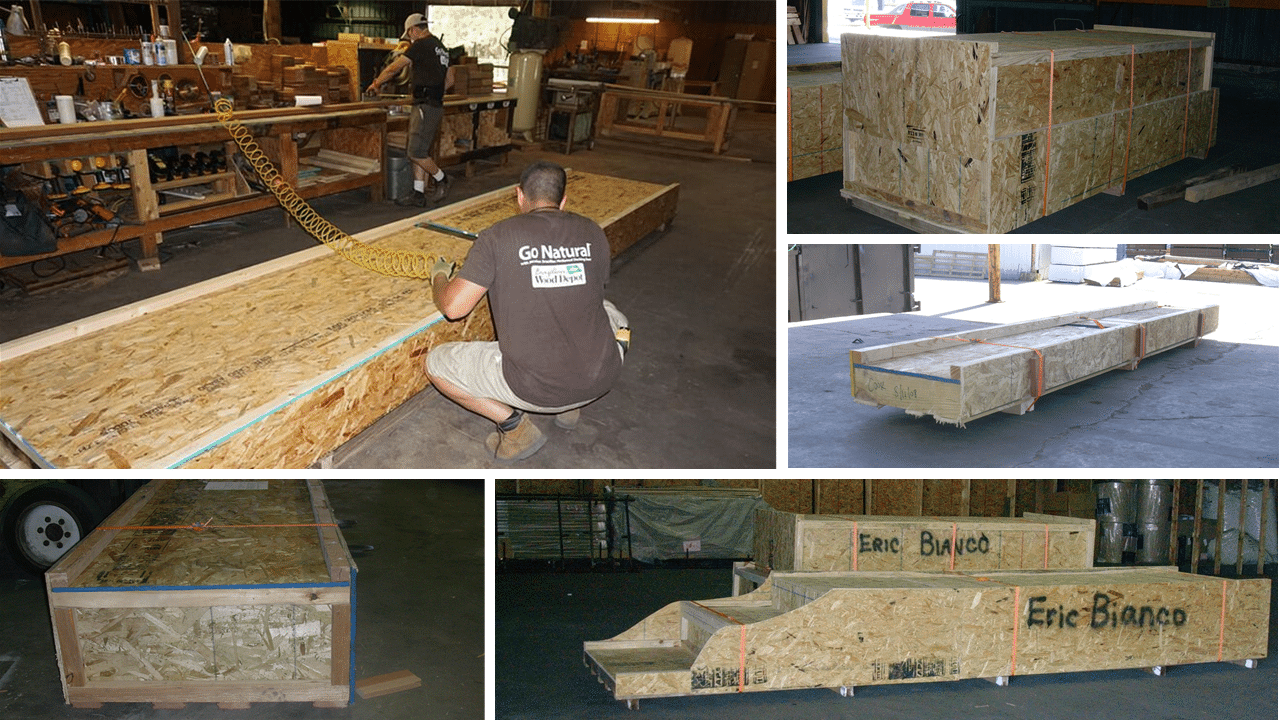Brazilian Wood Depot
6770 Buford Highway NE
Atlanta, GA 30340
Remember to change the Video Quality to, 2160p60 4k, to see the full resolution video! Click the cog-shaped settings button, select Quality, and then select 2160p60 4k.
About Balau (Shorea Spp.)
Balau (pronounced Buhl-ow) is also known locally as Bangkirai. Unlike the other wood species that Brazilian Wood Depot carries, Balau is native to Southeast Asia namely, Indonesia and Malaysia. While Balau is relatively new to the United States, it is the European and Australian Standard for high-end exterior hardwood construction. Its hardness, density, and durability rivals that of the Brazilian Hardwoods at a much more accessible price point. Its natural resistance to insects and mold also contributes to its longevity.
Balau decking is incredibly versatile. Its durability and longevity make it a natural choice for commercial projects, such as high-traffic, large-scale beach piers or boardwalks, or even public benches. However, its beauty, strength, and low-maintenance nature make it a top choice for residential applications.
Can you tell which is which?
Brown Balau Vs. Ipe
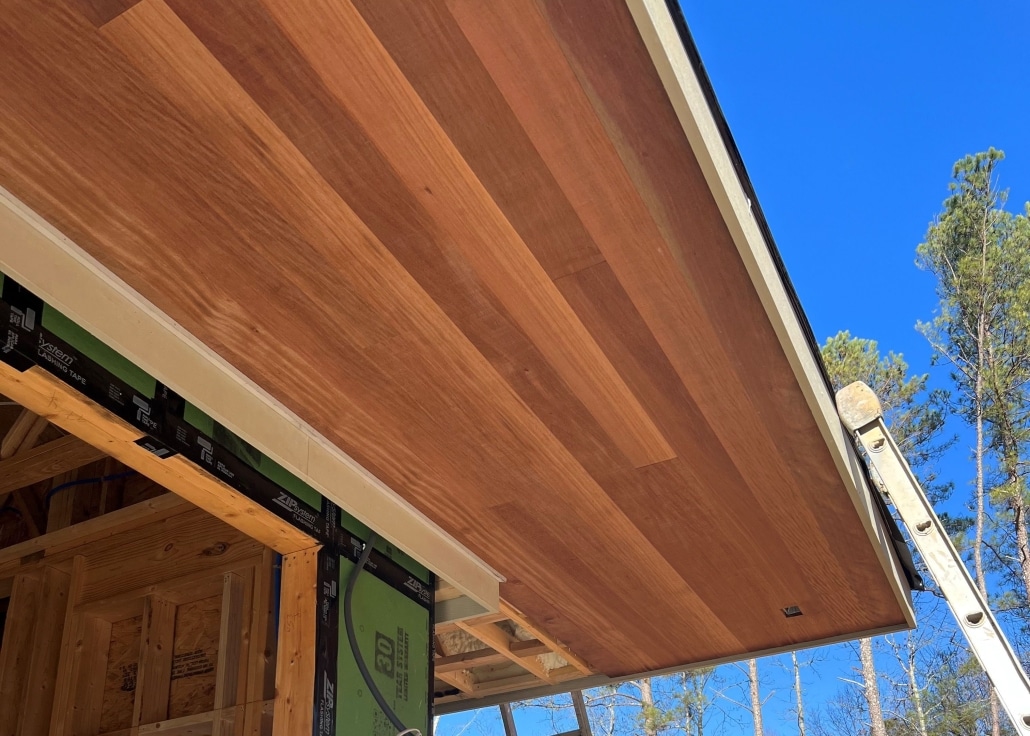
Brown Balau
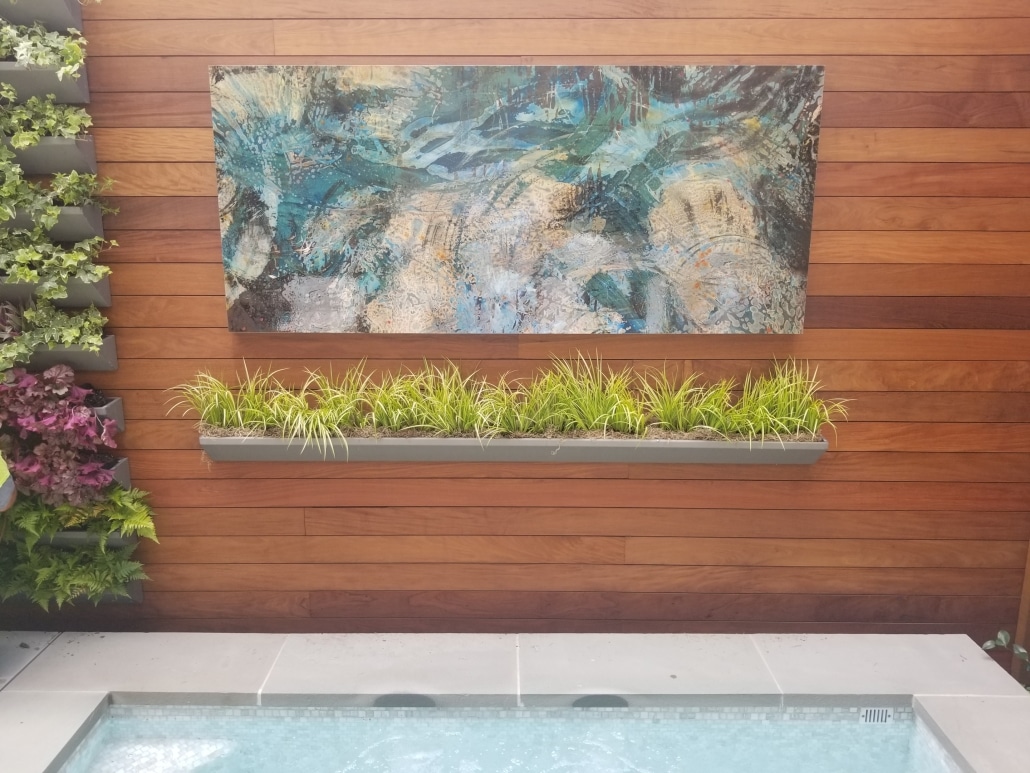
Ipe
Pictures don’t always tell the full story. Lighting, type of camera used, and the time of day can distort colors. However, these images have not been altered or enhanced in any way except for cropped, for size. Both of these photos were sent to us by our customers.
Balau Gallery
Color Change Progression of Balau
Champagne AND Brown Balau Fresh and Oiled
The photo above shows two pieces of Champagne Balau and two pieces of Brown Balau oiled with Messmer’s UV Plus Natural (light colored boards are the Champagne, the dark ones are Brown).
Champagne Balau After 22 Weeks in Full Weather
Here are the two Champagne Balau boards, after 22 weeks of heavy sunlight exposure on our roof. Grey remarkably similar to Garapa.
Brown Balau After 22 Weeks in Full Weather
Here are the two Brown Balau boards, after 22 weeks of heavy sunlight exposure on our roof.
Brown and Champagne Balau Weathered for 22 Weeks and Reoiled
Each of these boards have been re-oiled with Messmer’s UV Plus Natural. As you can see, oil has brought nearly all of their original colors back to life!
Benefits of Balau Decking
Balau Decking, also known as Bangkirai, has a number of qualities that make it stand out as a superior outdoor construction material.
- All Natural– Unlike composite decking, which is a combination of wood pulp and plastic, a non-recyclable material that pollutes our planet and pressure treated or reclaimed lumber that is loaded with toxic chemicals known to harm surrounding plant and animal life, Balau is 100% natural. It is ideal for repurposing, bio-degradable and does not create any biproducts that can harm the environment. No chemicals or plastics whatsoever, just 100% real wood. That’s why we say, “Go Natural!”
- Hardness– Balau is an internationally recognized Hardwood with a Janka Hardness rating of 1798. Compare that to Oak, at about 1,200. This extreme hardness lends to its dimensional stability, long lifespan, and natural weatherproof properties. Pressure treated wood is known for substantial expansion and contraction with seasonal changes. This process destroys the cell structures from the center of the boards, outwards. It also increases the rate of decay. This movement is also responsible for creating raised wood grain that can be painful to walk on without shoes. Raised grain is a common problem with pressure treated woods but does not occur with tropical hardwoods like Balau. Composite and plastic decking will also expand and contract significantly over time which compromises the rigidity. This eventually leads to boards drooping between the joists. Balau, being so hard, will expand and contract some, but very little. Minimal movement is one key element to Balau’s incredible longevity.
- Longevity- Balau is renowned for its ability to last many decades even in extreme weather conditions. Density and hardness, as discussed above, plays a large role in that. Natural resistance to water penetration and rot/decay also contributes to its longevity. The forests, from which they evolved, experience 100-400 inches of rain per year. That is up to 8-10 times more than anywhere in the United States. Evolutionary responses to this heavy rainfall have made this wood naturally resistant to water penetration, mold, rot and decay.
Board Replacement- Many people fail to consider how board replacement can be a HUGE obstacle with alternative deck materials like PT or composite. Let’s say you drop the hot contents of a grill on your deck and it damages the boards beyond repair. Unfortunately, if you don’t have a Balau or tropical hardwood deck, you’re in for a rude awakening. When you replace a PT or Composite deck board, it will stand out from the others, dramatically. These materials are all very consistent and continue fading over time. So, the new boards will ALWAYS stand out from the others. You are left with a deck that has very obvious patchwork. Tropical hardwoods vary from board to board, so replacing boards is no big deal. They may stand out from the others for a couple of months, but before long no one will be able to tell the new boards from the original ones. This benefit is specific to real, natural woods. Board replacement is also a common problem with prefinished and engineered wood flooring.
- Insect Resistance- Balau and other tropical hardwoods, are naturally insect resistant. Domestic lumber is treated with chemicals to deter wood boring insects. Balau evolved in forests with insects much more proficient at wood-boring than their North American counterparts. Very few insects in their natural habitat are capable of infiltrating their tough wood fibers and certainly, the domestic insects of the United States are no match. This is true for most tropical hardwoods.
- Forest Stewardship- Balau is sourced from the tropical forests of Southeast Asia; the Philippines and Myanmar in particular. Balau is also known as one of the most abundant hardwood species in the world. It is possible that Ipe and Cumaru become uneligible for international trade in the next few years. Fortunately, Balau is nearly guaranteed to be available for decades to come!
- Cost- Contrary to popular belief, Balau is VERY cost-effective when compared to composite alternatives. Plastic and composite boards will typically begin to fade and deteriorate within a few years. A composite deck is unattractive and nearly unusable after about 8 years. Alternatively, Balau is known to last from 20-30 years, depending on the environmental conditions. When you consider the cost of replacing pressure treated or composite boards through the life of just one installation of Balau, Balau is far, far more cost effective. The front-end cost of Balau decking is generally the same as the low-end composites and outperforms them in every measurable metric. Pressure treated lumber is cheaper than Balau, but you’ll replace the PT boards 5 times in the life of one Balau deck. So, is Balau the most cost-effective decking? Yes, usually in the short-term, but always in the long-term.
Balau Decking V.S. Other Decking
| Balau Decking | CCA-TREATED PINE | COMPOSITE DECKING | |
| Type | Hardwood | Softwood | Plastic |
| Maintenance | Low | Varies | Varies |
| Decay Resistance | High | Varies | Varies |
| Termite Resistance | High | Varies | Varies |
| Strength | High | Medium | Low |
| Movement in Service | Low | High | High |
| Fire Rating Class | High | Varies | Low |
| Hardness | 1798 | 690 | 940-1,390 |
For a more comprehensive comparison of decking materials, visit: Composite Decking vs. RealWood
Read More
To start with the obvious, Trex and other Plastic or Composite Decking alternatives offer no natural features. Plastic or Composite options are either all grey or all beige or somewhere in between. All the boards will be exactly the same color with the exact same printed grains. Ipe Decking and other Brazilian Hardwood Decking offer only real, natural wood colors with real, natural grains. This means a beautiful variation of boards with each a unique grain pattern on every deck. The next downside to Plastic or Composite Decks is their inability to be repaired. If a board(s) gets damaged, scratched, stained or broken, the damaged piece cannot be fixed because Plastic and Composite Decking fades with time and exposure to the elements. If you were to replace one board on a Plastic Deck or Composite Deck, it would stick out, very obviously, from the other boards. The new boards would be the ‘manufactured’ color, while the others would be faded. This disparity will never even out. Moreover, Plastic and Composite Decking cannot be pressure washed or sanded to restore color. You are never really able to bring a Plastic or Composite Deck back to its original condition without replacing all of the boards.
Ipe Decks, on the other hand, can easily be brought back to their original condition. Keeping with the scenario outlined above, if a board on an Ipe Deck is damaged and needs to be replaced, all you would need to do is get a replacement board to put in its place. Because the color of Ipe varies from board to board, it would not stand out from the other boards at all. It’s natural variability in color lends to its advantage if a board ever needs to be replaced. Alternatively, if the board was scratched or stained, one merely needs to sand the surface of the stained board(s) and reapply the UV oil to bring them back to their original condition. Ipe Decks last forever not only because of their resilience to rot and decay, but also because the boards CAN be repaired, a quality not found in any other decking material. Another aspect that many people fail to consider before installing a deck is Heat Dispersion and Flammability. Wood is the best decking material for disbursing heat making the deck cooler to walk on and Ipe also has a similar fire rating to concrete. Basically, it’s a naturally non-combustible material. Plastic and composite decking is very hot and can create a fire hazard if installed outside a UV reflecting window.
Finally, the last major downfall of Plastic and Composite decks, sagging and drooping. The chemical combinations for Plastic and Composite decking options have changed over the years in an attempt to avoid problems like, insects, mold, and rot. Unfortunately, one problem that has yet to be tackled by even the most advanced Plastic or Composite Decks is sagging and drooping. Sagging and drooping refers to the pendulous deformation of deck boards between the joists. As far as longevity goes, this is the main problem for Plastic and Composite Decks. After several years, the chemical components in the decks breakdown which compromises the rigidity of the boards. It can compromise the strength in such a dramatic manner that the boards themselves loose their ‘straightness’ and droop between the joists. This is an extremely well-known problem for Plastic and Composite decks that has never been successfully addressed. Ipe Decking is 100% natural. There are no non-organic chemicals to breakdown. Ipe’s high density and hardness that lends to its’ incredible dimensional stability is why Ipe decks outperform Plastic and Composite decks in regard to longevity, 10 to 1. These are just a few reasons that Ipe Decks are the preferred choice over Plastic and Composite Decks. All considered, there really is no comparison between an Ipe Deck and a Plastic or Composite Deck.
Contact us with any questions on comparisons of Ipe and composite decking.
Finishing and Maintenance
To oil or not to oil, that is the question. With Balau or any other tropical hardwood from Brazilian Wood Depot, you have basically two options when it comes to maintaining your deck, but you don’t have to stick with either one. You can either skip the oiling and let the boards go a beautiful silvery-grey or use oil to maintain the natural brown colors. Below, I’ll go into what both options mean for you and your deck.
First, what happens when you do not use a UV protectant oil? The purpose of UV Oil is to protect the wood from ultraviolet rays emitted by the sun. These rays eventually ‘bleach’ the boards of their natural brown color. What’s left, after significant sunlight exposure, is a beautiful silvery-grey surface that has a natural ‘reclaimed’ appearance.
Typically, the board colors become more consistent with more time left in the sun without UV protection. The ‘greying’ process will not affect the structural integrity, lifespan, or water resistance of the boards. Let’s say, when the deck was originally installed, you didn’t apply the oil because you wanted the deck to turn grey. You can bring Balau back to its original condition. It may require a cleaning before oiling, just follow directions in the video, above.
Second, you do want your deck to hold its natural color. First off, you’ll want to use a UV Oil. It is not a “stain” nor a “sealer”. These terms are not technically accurate because UV Oil is not meant to provide a color change like “stain” or water protection like a “sealer.” Balau and similar tropical hardwoods have natural colors and they are naturally resistant to water penetration, so stains and sealers are not only unnecessary- they are improper.
If you are planning to maintain the natural color, we recommend using Messmers Ipe Hardwood Deck Stain. There are other products that also work to protect the natural colors of Balau and tropical hardwoods, but this is the product we have been recommending for +10 years. It comes in three colors, but the preferred color is “Natural.” The finish protects the wood well and contains transparent iron oxide pigment. This pigment absorbs UV radiation yet at the same time will allow visible light to pass through it. The staining results you’ll get are a finish that highlights the natural beauty of the Balau wood and at the same time protects it. Your deck will not fade in the sun as this product has excellent resistance to UV degradation. Maintaining the color of your deck typically involves annual oiling followed by periodic cleaning every 2-3 years. For more information on how to maintain the color of your Balau deck see the video above, Ipe Deck Maintenance
FULL Cleaning and Oiling Instructions PDF
Choosing to finish your deck or leave it unfinished is a personal choice and you can’t go wrong either way. Brazilian Wood Depot is here to help you decide whether or not to stain your Balau deck. We will be happy to discuss your options.
 Working with Balau
Working with Balau
Storage and Handling
For out-of-state (outside of GA) installation, it is required that the materials acclimate to the climate conditions of the job site before installation; allow materials to acclimate to the job-site climate for ten (10) days prior to installation. Utilizing spacers or stickers between boards to allow air movement and natural drying also aids the acclimation process. Always store materials flat and keep dry and covered prior to installation. Installing wet or saturated boards may result in shrinkage. Refer to the Installation Requirements document for more information.
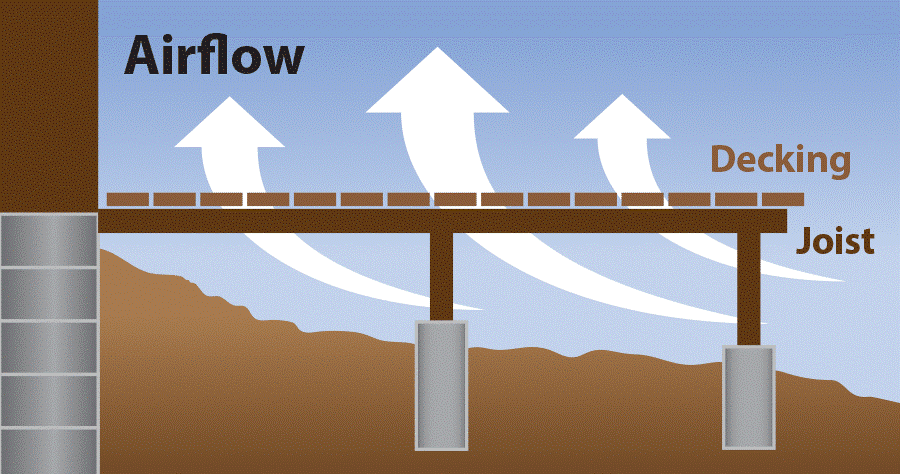
When designing your deck, you must provide for adequate ventilation to assure long term stability and avoid cupping. Proper air ventilation allows air to flow in from outside the deck area and under the joists to evaporate moisture. Gently sloping the soil under the deck away from the house and covering the soil with plastic is recommended for any type of deck installation. Allow a 1/8″ gap between standard deck boards for drainage and airflow. More detailed instructions can be found on the Installation Tab and the Installation Requirements documents. There are a number of different fastening methods; Face Screws, Kerf and Clips, Grabber Bars, Camo, or ProPlug. For a more detailed description of these fasteners visit the Accessories Tab.
Lumber Profiles
Brazilian Wood Depot is excited to now offer Balau Decking in 5/4×6!
Brazilian Wood Depot also carries a number of different profiles to accent different features of your deck like stair risers, balusters, railing sections, handrails, facia, posts, etc… These profiles are generally only offered in Ipe. Ipe dimensional lumber accents Balau decking perfectly and is the preferred choice for the deck features mentioned above. Refer to the Profiles and Dimensions document for profile availabilities.
Architect and Design Resources
We are very proud to announce that Brazilian Wood Depot, with the help of CADdetails.com, has made specifying Brazilian Hardwood Decking and Siding much easier!
Incorporate Brazilian Hardwood Decking and Siding products into your
plans quickly and easily by downloading our design files from
CADdetails.com. CADdetails is specifically designed for architect and
design professionals aimed at getting manufacturer-specific product
information for working plans.
On our Microsite, you’ll find CADs, Specifications, BIMs, 3D Models, and other design-related media for Brazilian Wood Depot and BWD
products. This database will continue to grow in the coming weeks
and months.
Click here to visit our Architect and Design Library at CADdetails.com
Lucy’s Most Frequently Asked Questions
How do I clean and refinish my deck?
See the cleaning and maintenance instructions here. These instructions are accompanied by two demonstration videos! This document will tell you everything you need to know from the products we recommend to the processes that have had the most success.
Maintenance of hardwood decking is nearly always the same, regardless of the species.
Should I pressure wash my deck before finishing it?
NO. Pressure washing it can leave streaks, potentially tear up the surface of the wood and will not clean as deeply as the cleaner.
Where does Brazilian Wood Depot Ship?
We ship to all areas of the US.
What is BWD’s return policy?
Please see our Purchase Policy for detailed information.
How does the cost of Composite Decking compare to Hardwood Decking?
The range of composite decking prices covers about the same range of the different hardwood decking options. Taking into consideration the long life, durability, beauty, and stability of hardwood decking compared to composite: hardwood decking costs less over the lifetime. Visit our comparison page for more information.
For additional FAQ’s visit our FAQ’s Tab.
Quotes and Samples
Brazilian Wood Depot is here to help! We pride ourselves on superior customer support and turning around samples, quotes, and orders faster than anyone else. Please call us for samples or quotes, 770-242-0045.
Generally, all we need to get started on pricing your deck is the answer to a few, basic questions. We can help you answer these questions too:
- What species? With Six incredible Brazilian Hardwood species, deciding on just one can be a difficult task. I’d recommend familiarizing yourself with the different options on the Decking Tab or this Video.
- How will you fasten the boards? Whether you are using face screws, hidden clips, grabber bars, or the Camo system, we’ve got you covered. The decision is yours to make and your installer can also help guide this decision based on their preferences. Visit the Accessories Tab for more information on fastening methods.
- What are the basic dimensions of the deck and the joist spacing? Obviously, we’ll need to know the size of the deck to get things started. Joist spacing information allows us to quote accurate fastening quantities.
- Additional Deck Features? You don’t need to know all the intricate details of your deck design to get a basic quote, but if you do have the information it can help make the quote more accurate. Additional features would include; steps, risers, posts, railing sections, handrail, and facia.
This is all we need to get started pricing your new deck. Again, we’re here to help you make the best decisions for your deck. You can reach us anytime at, 770-242-0045.
Shipping and Delivery
Brazilian Wood Depot has the most robust shipping process, IN THE INDUSTRY! There’s no debate about that and we know it! Every LTL shipment is fully crated to prevent damages.
We are now also offering LIVE 4G GPS TRACKING on LTL shipments! We are the only distributors in the industry that offer this service! You’re going to love it!
Read more about our robust shipping process, www.bwdepot.com/shipping


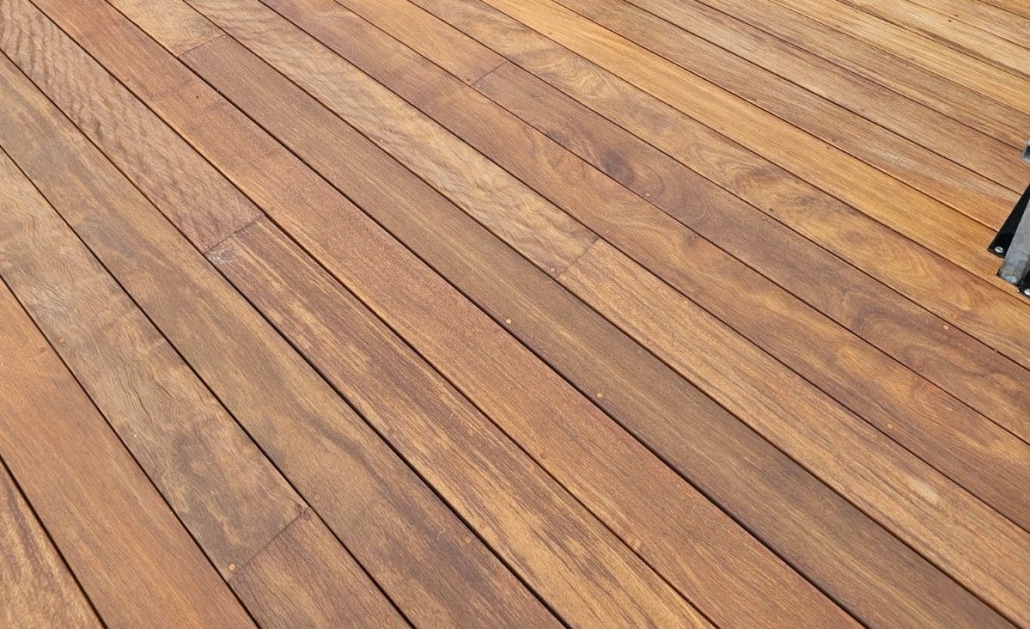
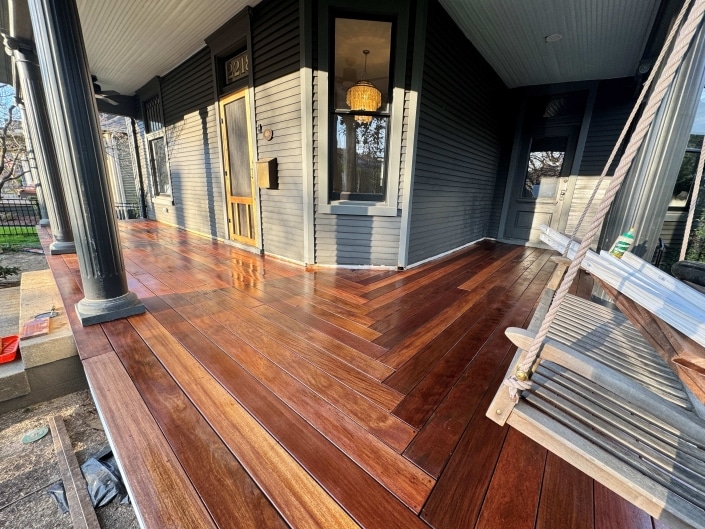
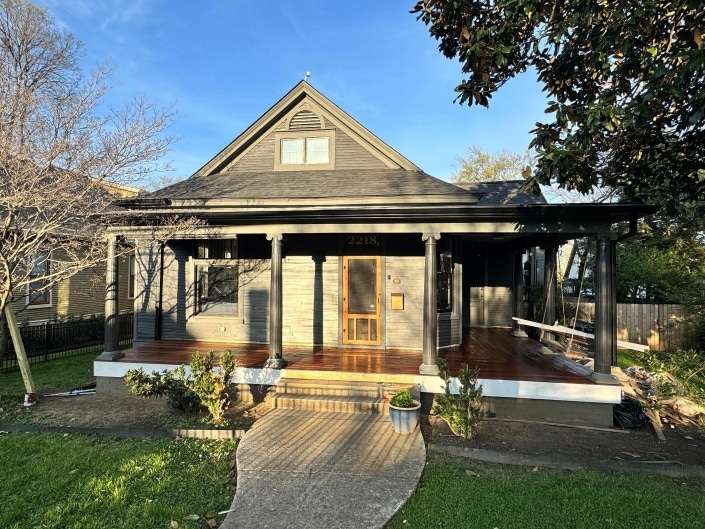
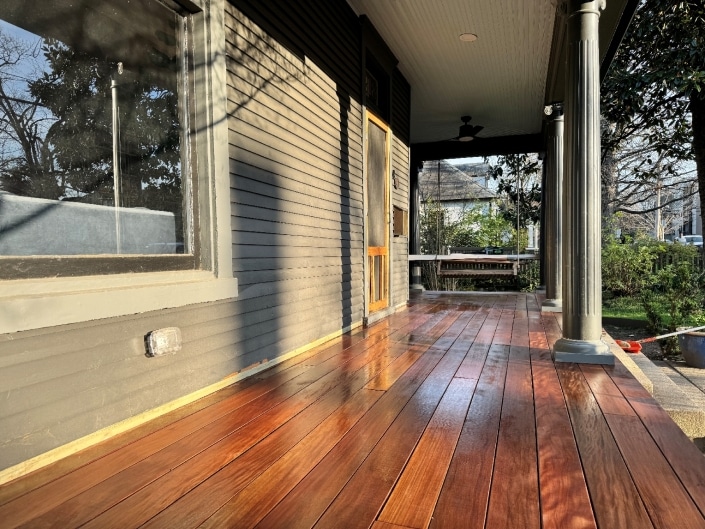
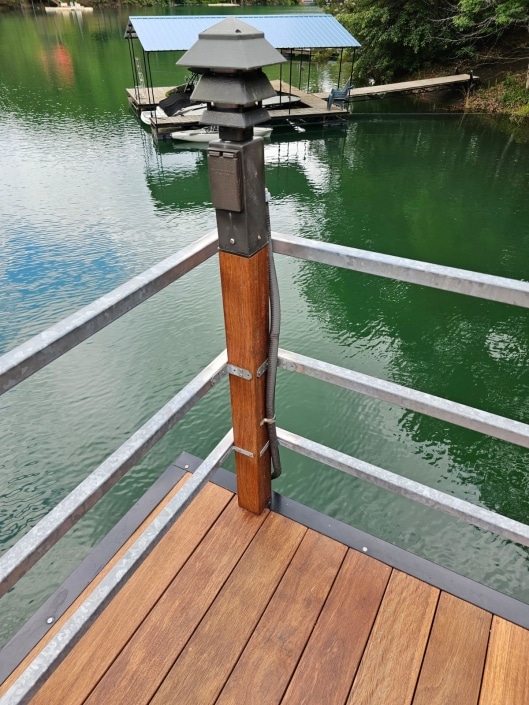
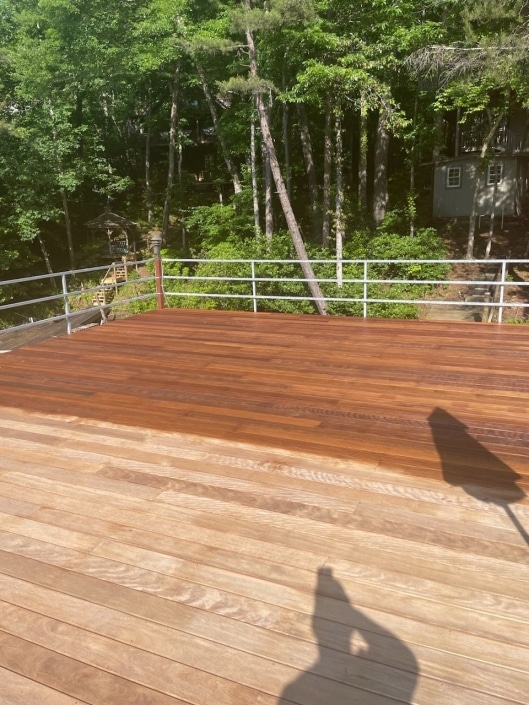
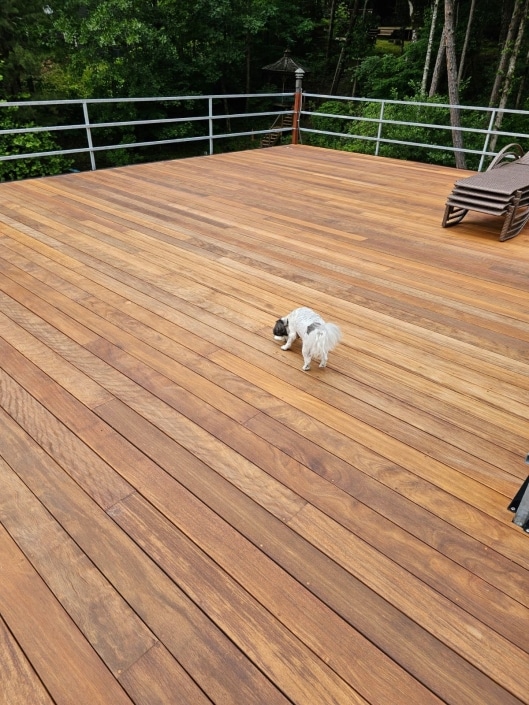
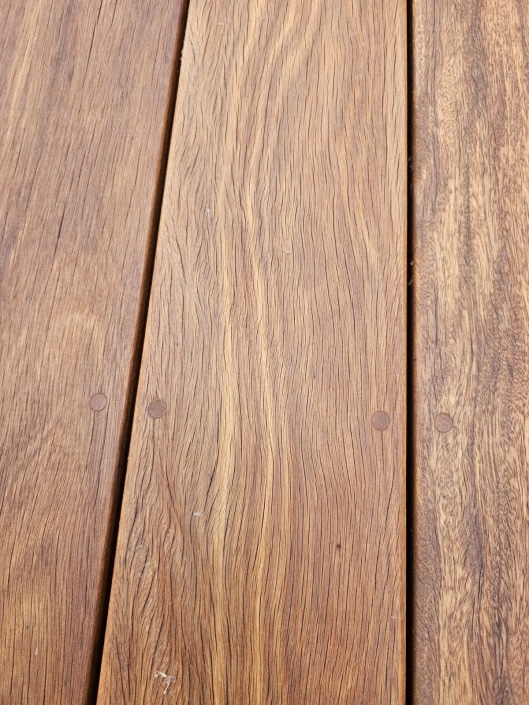
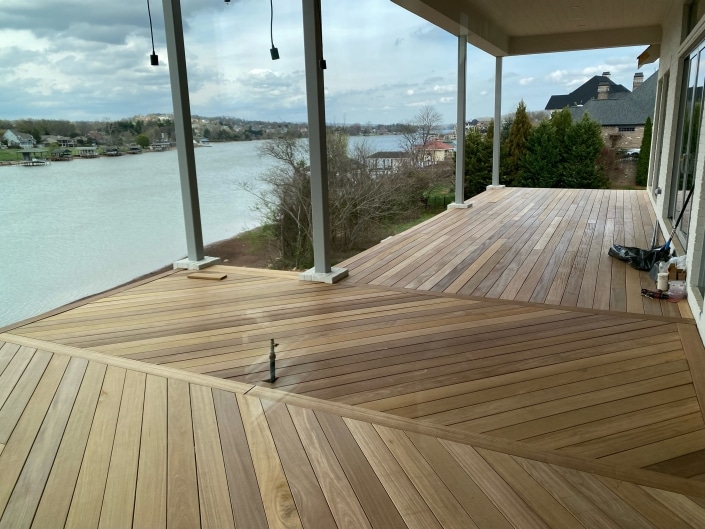
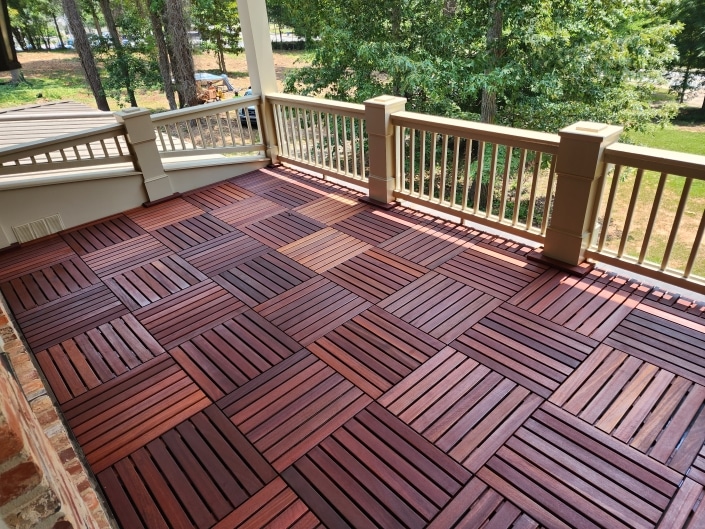
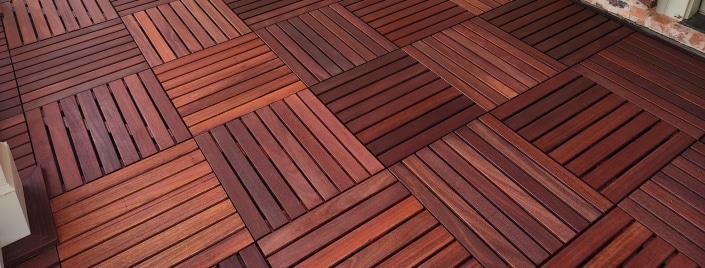
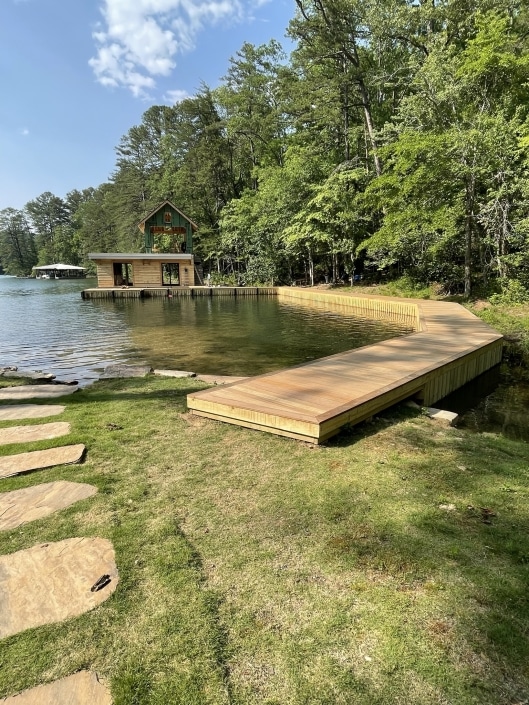
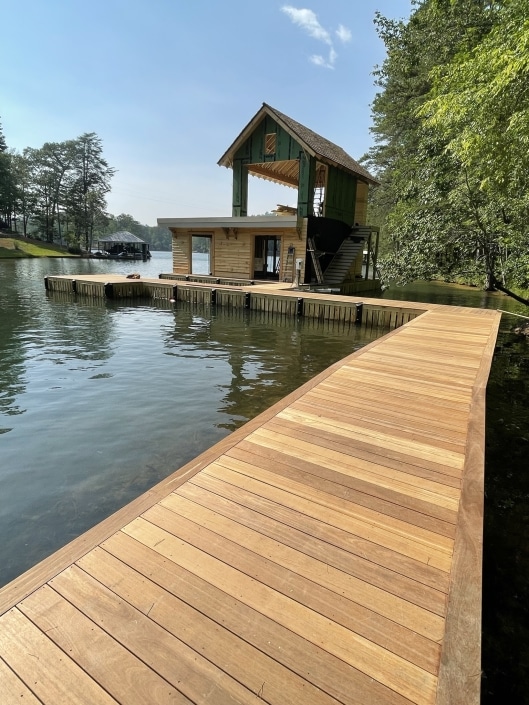
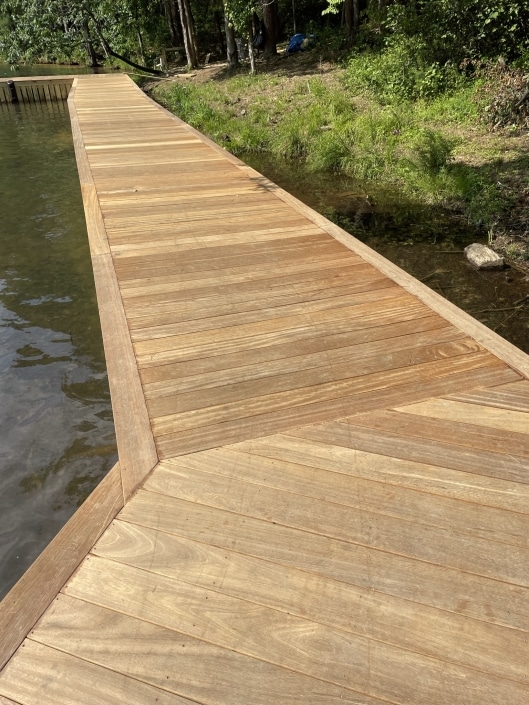
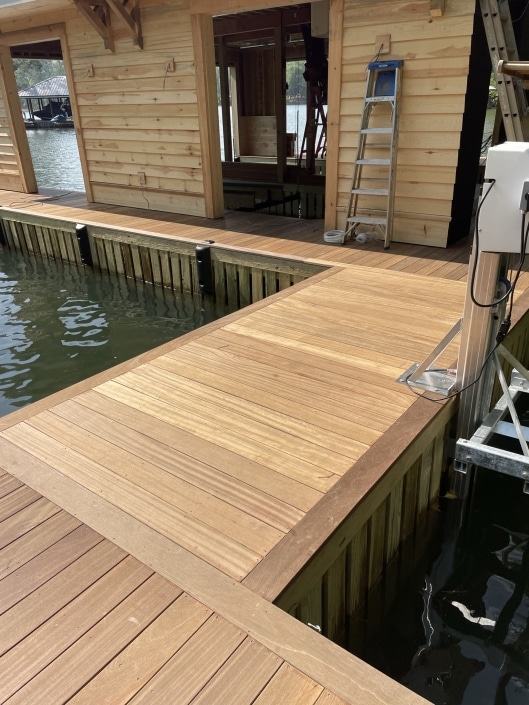
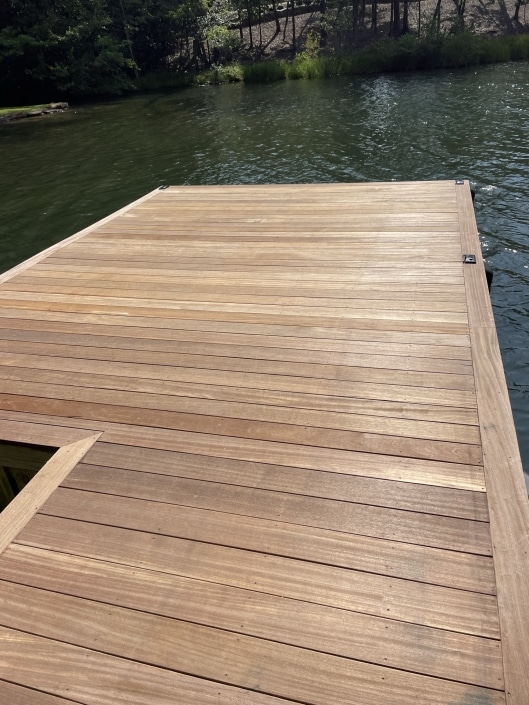
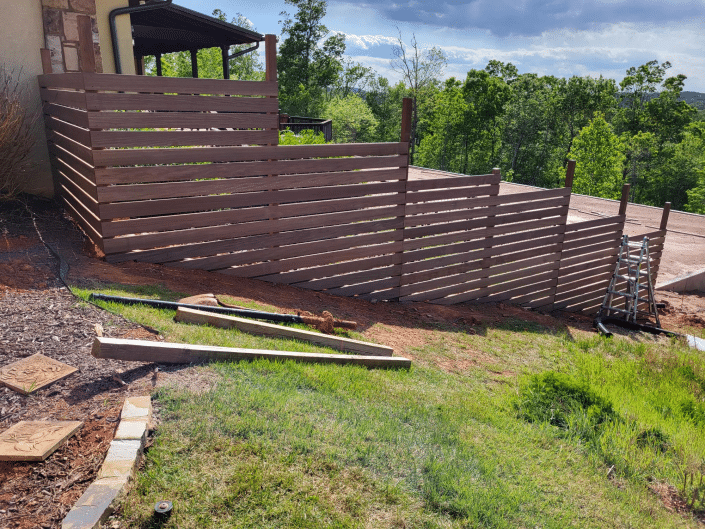
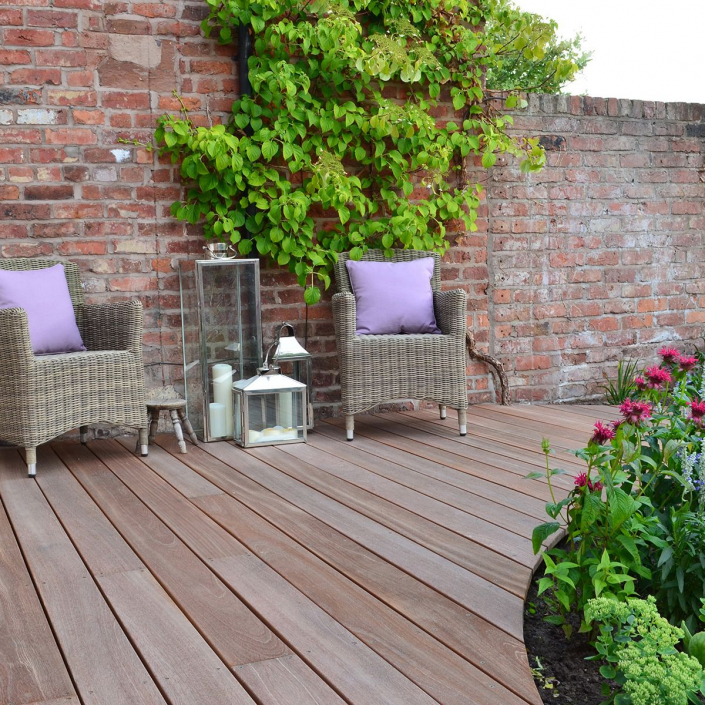
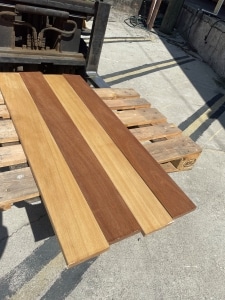
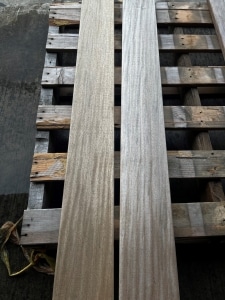
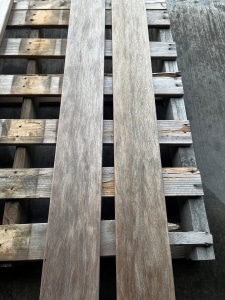
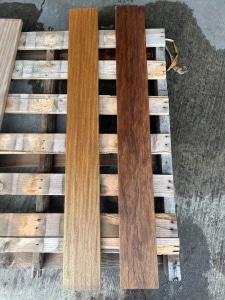
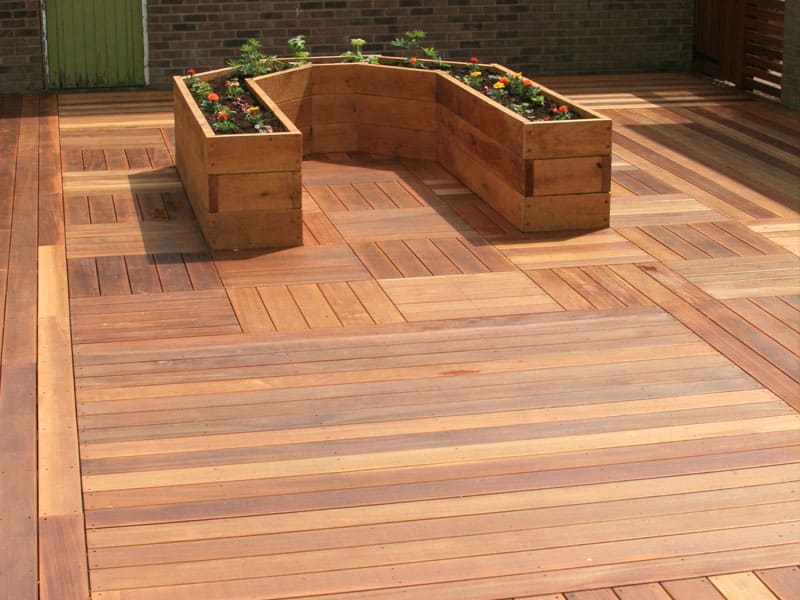 Board Replacement- Many people fail to consider how board replacement can be a HUGE obstacle with alternative deck materials like PT or composite. Let’s say you drop the hot contents of a grill on your deck and it damages the boards beyond repair. Unfortunately, if you don’t have a Balau or tropical hardwood deck, you’re in for a rude awakening. When you replace a PT or Composite deck board, it will stand out from the others, dramatically. These materials are all very consistent and continue fading over time. So, the new boards will ALWAYS stand out from the others. You are left with a deck that has very obvious patchwork. Tropical hardwoods vary from board to board, so replacing boards is no big deal. They may stand out from the others for a couple of months, but before long no one will be able to tell the new boards from the original ones. This benefit is specific to real, natural woods. Board replacement is also a common problem with prefinished and engineered wood flooring.
Board Replacement- Many people fail to consider how board replacement can be a HUGE obstacle with alternative deck materials like PT or composite. Let’s say you drop the hot contents of a grill on your deck and it damages the boards beyond repair. Unfortunately, if you don’t have a Balau or tropical hardwood deck, you’re in for a rude awakening. When you replace a PT or Composite deck board, it will stand out from the others, dramatically. These materials are all very consistent and continue fading over time. So, the new boards will ALWAYS stand out from the others. You are left with a deck that has very obvious patchwork. Tropical hardwoods vary from board to board, so replacing boards is no big deal. They may stand out from the others for a couple of months, but before long no one will be able to tell the new boards from the original ones. This benefit is specific to real, natural woods. Board replacement is also a common problem with prefinished and engineered wood flooring.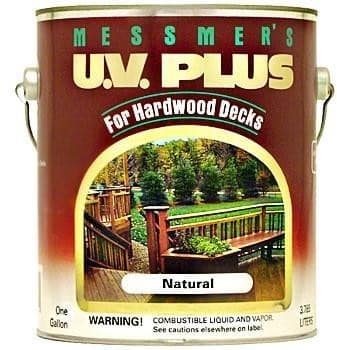
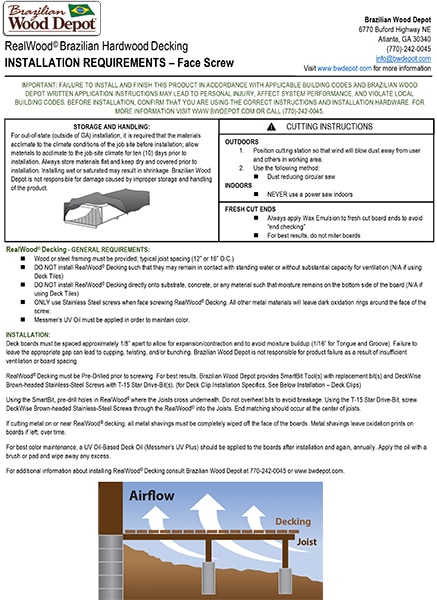 Working with Balau
Working with Balau